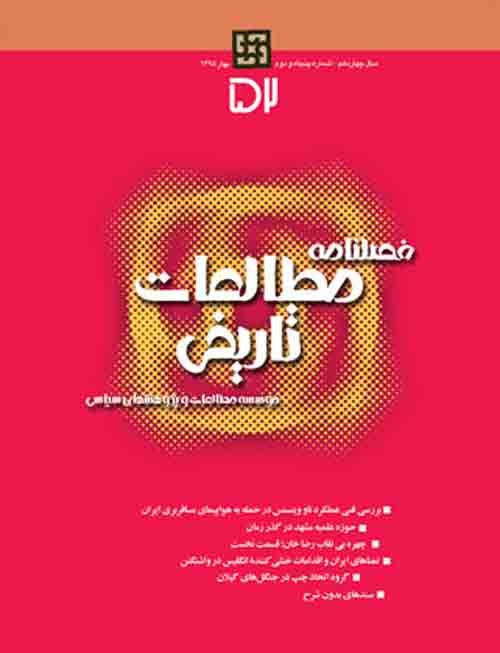فهرست مطالب

نشریه مطالعات تاریخی
پیاپی 52 (بهار 1395)
- تاریخ انتشار: 1395/03/22
- تعداد عناوین: 7
-
صفحه 8
-
صفحه 43
-
چهره بی نقاب رضا خان؛ قسمت نخست / مصاحبه با قاسم تبریزیصفحه 79
-
صفحه 135
-
صفحه 169
-
Page 11In “Rereading a genocide case” about USS Vincennes attack on Iran Air Flight 655 on July 3rd 1988, the author has tried to present some exact info about the details of this historical genocide of US military and also present a firsthand narrative about this event based on documents and interviews of Iranian and US officials. In this article Vincennes attack on Iranian civil airplane has been analyzed as one of documented US involvement in Iraq-Iran War. The author has also tried to show the effects of this terrible genocide on the trend of imposed war of Iraq against Iran and its negative impact of this in humane attack on Tehran-Washington bilateral ties.
-
Page 43This article first of all gives a brief history of Mashhad seminary as one of greatest Shia seminaries in the world during the past century and then introduces some of its instructors and official and educational trends during the last years. The main part of the article represents the Mashhad seminary’s role in his torical events during the last century including Constitutional Movement, bombarding Imam Reza Holy Shrine, putting pressure on Mashhad Seminary by Reza Shah after surpassing Goharshad Mosque because of unified garment law and unveiling women, taking position of Mashhad clergy agains t Iranian Land Reform, opposing June 5th 1963, passing capitulation in Iranian parliament in 1964 and finally Mashhad seminary’s role in the victory trend of Islamic Revolution in January 1978 until February of 1979.
-
Unveiling Reza Khan: Part I / Interview with Ghasem TabriziPage 79In order to understand the realities of Reza Khan’s time and life in the historic base of Iran during the three early decades of 20th century a detailed interview has been conducted with Ghasem Tabrizi, Iranian Contemporary History researcher. In the first part of this interview the foregrounds of British coup in Iran and Reza Khan’s rise to power are discussed. There other issued which can be traced in this interview are: Constitutional Movement in Iran, the reasons for misleading this movement and the other political and social surpassed moves that happened between 1906 and the coup in 1921. In this interview the main existing questions about Reza Khan’s attempts are discussed through the eyes of his supporters and the ones who opposed him. In this regard the reasons behind Qajars’ fall, the tendency for republicanism instead of royal regime in Iran and Reza Khan and British renunciation of this plan are discussed. In this interview the viewpoints of Reza Khan’s supporters and the Persian books in this regard are critically reviewed.
-
Page 107Chapter 4 of The Bridge to Victory and A Land of Famine second edition which is going to be published soon represents the requests of Iran from the US government for providing necessary food resources for Persian people during the early decades of 20th century. In this book M.G. Majd (PhD) based on US Foreign Secretary documents shows that the US government denied the repeated requests of Iranian government for providing essential needs such as grain, transport necessary needs like tires and spare parts of trucks for carrying food stuffs. The documents show that the British have had a destructive role in shaping US denial of Iranian repeated requests. It is interesting that the US government despite insisting on friendly ties between two countries would continue denying Iranian requests or only would afford them partly.
-
Page 135In this issue of “History Narrated by Documents”, the report compiled by Islamic Revolutionary Guard Corpse official in the town of Chuka for IRGC 6th District headquarters in the city of Rasht is represented to the Quarterly’s readers. This historical document since being produced in the closest time to the terrorist operation made by the so-called group of “Left Unity” in Guilan Jungle is so important. This document represents a full detailed eye witnessed report about terrorist operation of Left Unity, People’s Devotees Guerrilla Organization (Minority), Democratic Movement, Unified Left Council, Communist Union, and Mujahedin Khalq Organization for history researchers. This report can also be a very good source for exact recognition of postrevolutionary events in Guilan, Hashtpar and Talesh. Clearly, in order to have a better understanding of the developments and their impact on the later events in that district, the other reports and documents in this regard should be comprehensively studied all together.

